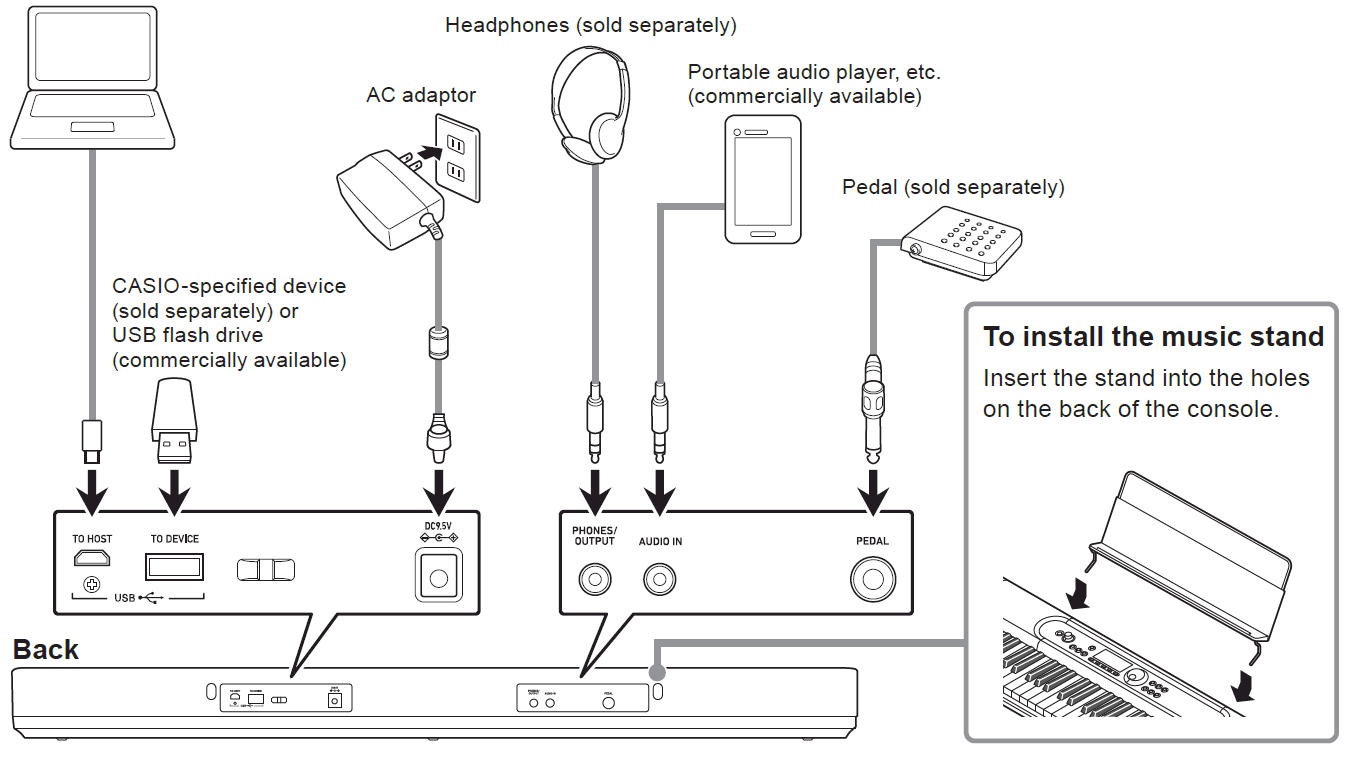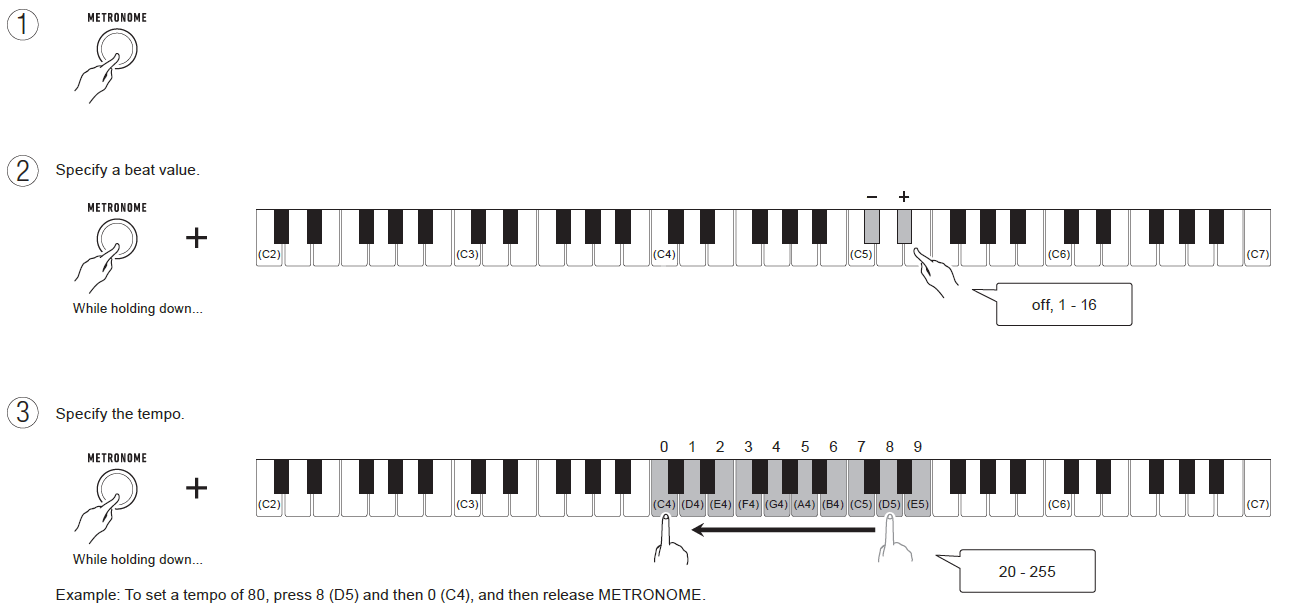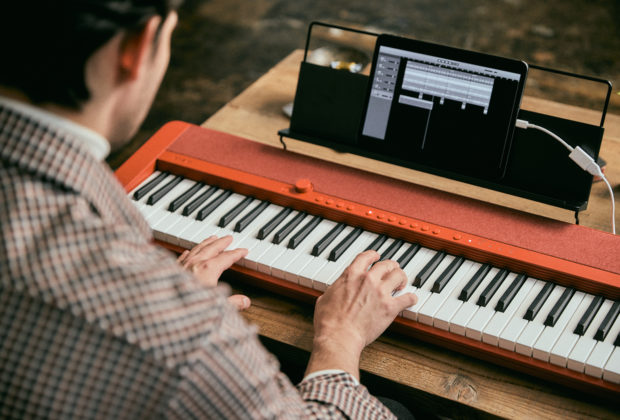Casio tone CT-S1 Piano
Included Accessories
- Music Stand
- Strap Lock (enclosed with music stand)
- Leaflets
- READ THIS! Sheet
- Other (Warranty, etc.)
Items included as accessories are subject to change without notice.
Preparation
Preparing a Power Supply
Using the AC Adaptor:
Connect the AC adaptor as shown in the illustration on the right.● Make sure that you use only the AC adaptor specified for this Digital Keyboard.
Using Batteries

Load six AA-size batteries.

Specify the battery type.See “Configuring Function Settings” on the reverse side of this sheet.
Computer, smartphone, etc. (commercially available)• Connect using a USB cable that is no more than two meters long.
Basic Operation

- (Power) button: Press to turn on power. Longpress to turn off power.
- VOLUME knob: Rotate to adjust overall volume
- HOME button: Press to return to the Home screen. (Home Customization supported)
- SURROUND button: Press for a more expanded sound. (Disabled while headphones are connected.)
- Dial: Rotate to change a displayed number or value.
- Pitch Bend Wheel: Rotate for a smooth change in the pitch of a note that is sounding.
- Auto Power Off: Automatically turns off power after 30 minutes of non-use. (On, Off switchable)
- Pedal: Sustains notes played while the pedal is depressed. Even if the keys played are released, notes are sustained as if the keys remain pressed, until the pedal is released.
- Touch Response: Pressing a key harder produces louder sound, while a softer key press produces softer sound.
Useful Functions
For details about operations, refer to the User’s Guide on the CASIO Website.My Setup: Save the current setup (tone, etc.) for later recall.Reverb: Output sounds using room, hall, and other acoustic effects.Octave Shift: Raise or lower the pitch of the keyboard in octave units.Transpose: Raise or lower the overall pitch in semitone steps.
Practicing with the Metronome

Selecting a Tone
To use the main tones to select an instrument
To select a tone using the keyboard keys

Product Specifications
Model: CT-S400/CT-S410Keyboard: 61 keysTouch Response: 3 levels, OffMaximum Polyphony: 48 notesTone Functions: 600 preset notesEffects: Reverb (20 types, Off); Chorus (10 types, Tone); DSPMetronome: Bell sound off, 1 to 16 beats;Tempo Range: 20 to 255Song Bank: 160 preset songs;Part Off Function: Left-hand, right-hand, both handAuto Accompaniment: 200 preset rhythms, 10 user rhythm, 200 one-touch presets, INTRO, ENDING; chord input mode switchingRegistration: Maximum 32 setups (4 setups × 8 banks)Demo Function: 1 Demo Song, 110 built-in Song Bank songsFunction Volume Adjustment: Metronome, Rhythm, SongMIDI Recorder: Real-time Recording, Playback;Tone recording songs: 1 song, RhythmRecording songs: 1 song,Multi-track recording songs: 5 songs, 6 tracks (1 system track, 5 solo tracks);Capacity: Approximately 40,000 notes (one song)Other Functions: Transpose (±1 octave, –12 to 0 to +12 semitones); Octave Shift (–3 to 0 to +3 octave); Tuning (A4 = 415.5 to 465.9 Hz; Default = 440.0 Hz), 12 Auto Harmonize types; 100 Arpeggiator typesPitch Bend Wheel: 0 to 24 semitonesAPP Function: iOS, Android supported (connected via the USB terminal)MIDI: 16-channel multi-timbre receive; GM Level 1 standardInput/output Terminals: PHONES/OUTPUTjack: Stereo mini jack (3.5mm); AUDIO INjack: Stereo mini jack (3.5mm) (Input impedance: 10kΩ, Input sensitivity: 200mV);USB TO HOST port: micro B;USB TO DEVICE port: Type A;PEDAL jack: Standard jack (6.3mm) (pedal sustain, sostenuto, soft, start/stop, fill-in, arpeggiator hold)Power Jack: 9.5VDCPower Supply: 2-way power supply; Auto Power Off (30-minute trigger time; Can be disabled)Batteries: 6 AA-size alkaline batteries or AA-size rechargeable nickel metal hydride batteries; Approximately 4 hours (alkaline batteries) or approximately 4 hours (nickel metal hydride batteries) continuous operation*
- Measured values while using eneloop batteries. eneloop is a trademark of Panasonic Corporation.
- Actual continuous operation time may be shorter due to battery type, performance type, and usage environment.
- Specifying the wrong battery type can cause incorrect display of the battery level and sudden loss of power.
AC Adaptor: AD-E95100L (JEITA Standard, with unified polarity plug)Speakers: 13 cm × 6 cm (oval) × 2 (Output: 2.5W+2.5W)Power consumption: 9.5V = 7.5WLCD: Adjustable contrastDimensions: 93.0(W) × 25.8(D) × 8.4(H) cm (36 5/8 × 10 3/16 × 3 5/16 inch)Weight: Approximately 4.5 kg (9.9 lbs) (Excluding batteries)Specifications and designs are subject to change without notice.
- Any reproduction of the contents of this manual, either in part or its entirety, is prohibited.Except for your own, personal use, any other use of the contents of this manual without the consent of CASIO is prohibited under copyright laws.
- IN NO EVENT SHALL CASIO BE LIABLE FOR ANY DAMAGES WHATSOEVER (INCLUDING, WITHOUT LIMITATION, DAMAGES FOR LOSS OF PROFITS, BUSINESS INTERRUPTION, LOSS OF INFORMATION) ARISING OUT OF THE USE OF OR INABILITY TO USE THIS MANUAL OR PRODUCT, EVEN IF CASIO HAS BEEN ADVISED OF THE POSSIBILITY OF SUCH DAMAGES.
- The contents of this manual are subject to change without notice.
- Company and product names used in this manual may be registered trademarks of others.
Declaration of Conformity
Model Number: CT-S400/CT-S410Trade Name: CASIO COMPUTER CO., LTD.Responsible party: CASIO AMERICA, INC.Address: 570 MT. PLEASANT AVENUE, DOVER, NEW JERSEY 07801Telephone number: 973-361-5400This device complies with Part 15 of the FCC Rules, Operation is subject to the following two conditions:
This device may not cause harmful interference, and (2) this device must accept any interference received, including interference that may cause undesired operation.
Functions Not Covered in This Manual
These instructions provide general information about main functions.For more detailed information, refer to the “User’s Guide”. https://support.casio.com/global/en/emi/manual/CT-S400/The “User’s Guide” includes information on the topics listed below.
- Saving a Setup (My Setup)
- Changing the Pitch in Octave Units (Octave Shift)
- Changing the Pitch in Semitone Units (Transpose)
- Changing the Scale (Scale Tuning)
- Playing with a More Expanded Sound (Surround)
- Saving and Recalling Setups (Registration)
- Other
References
[xyz-ips snippet=”download-snippet”]




